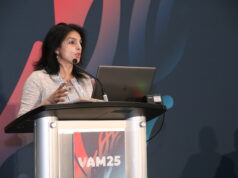 Society for Vascular Surgery (SVS) experts are spearheading initiatives as part of the multispecialty PAD Pulse Alliance and its Get a Pulse on PAD public awareness campaign aimed at educating and raising awareness of the risk factors and potential symptoms of peripheral arterial disease (PAD) among Americans. As the campaign gathers steam, the SVS is focused on closing the health equity gap with the aim of equipping patients with essential tools for early detection and treatment.
Society for Vascular Surgery (SVS) experts are spearheading initiatives as part of the multispecialty PAD Pulse Alliance and its Get a Pulse on PAD public awareness campaign aimed at educating and raising awareness of the risk factors and potential symptoms of peripheral arterial disease (PAD) among Americans. As the campaign gathers steam, the SVS is focused on closing the health equity gap with the aim of equipping patients with essential tools for early detection and treatment.
The collaborative effort with the Association of Black Cardiologists, Society for Cardiovascular Angiography & Interventions (SCAI) and Society of Interventional Radiology (SIR) has already seen SVS members take a central role as the campaign rolls out.
“This particular disease process, even though it’s an epidemic, is understudied, and the public does not have great awareness about the disease process and unfortunately tend to only find out about it when they’re in dire straits,” said Anahita Dua, MD, a vascular surgeon at Massachusetts General Hospital in Boston, one of the spokespeople for the alliance.
“PAD is unique in that it has multiple providers that are involved in caring for these patients. The whole point of the campaign is to show solidarity for our patients and to simultaneously build public awareness about the disease process.”
The Get a Pulse on PAD campaign, launched Feb. 8, includes a survey, media materials, a new website and a comprehensive media strategy to promote disease awareness. Dua has completed dozens of media interviews across TV and radio, with the campaign yielding nearly 200 million impressions across various social media platforms.
Additional SVS members will assist with local market media opportunities in the coming weeks and months. The campaign is the first step in a broader branding campaign to be launched by the SVS in the next few months.
The alliance conducted three distinct surveys, covering the general, Black and Hispanic populations, aiming to gain a nuanced understanding of perceptions of PAD.
The surveys demonstrated that 70% of Americans are unaware of PAD and that there is a disconnect between perceived and actual risk, especially among Black and Hispanic populations.
William Shutze, MD, a vascular surgeon at Texas Vascular Associates and one of the initiative’s chairs, expressed his initial astonishment at the survey results, emphasizing the role of raising awareness as the primary step in addressing the severity of PAD.
To maximize the campaign’s impact, initial media efforts were strategically directed toward regions with higher amputation rates. The campaign features not only digital content but also includes video and media interviews in Spanish, aiming to break down cultural and language barriers.
Dua explained how societies can utilize the information provided by the alliance to shape discussions with patients. “In this particular case, the doctors are unable to do their job for patients unless the patients themselves are aware of the disease process,” she said.
“Societies like the SVS that have a lot of power, reach and credibility can do things like this Get a Pulse on PAD awareness campaign where they join forces with other providers to put one message out there that says we care about you, our patients, and this is the way in which we want to provide you with the best care. There’s no point in having all these fancy tools in the hospital if the patient gets to you when it’s too late.”
A reassessment of the campaign is scheduled for October when the societies involved will collaborate to determine the next steps forward. Shutze emphasized the persistent nature of the problem, stating, “It’s not going to go away with one campaign. We’re going to have to roll up our sleeves and talk about how to sustain this momentum and keep it going.”











